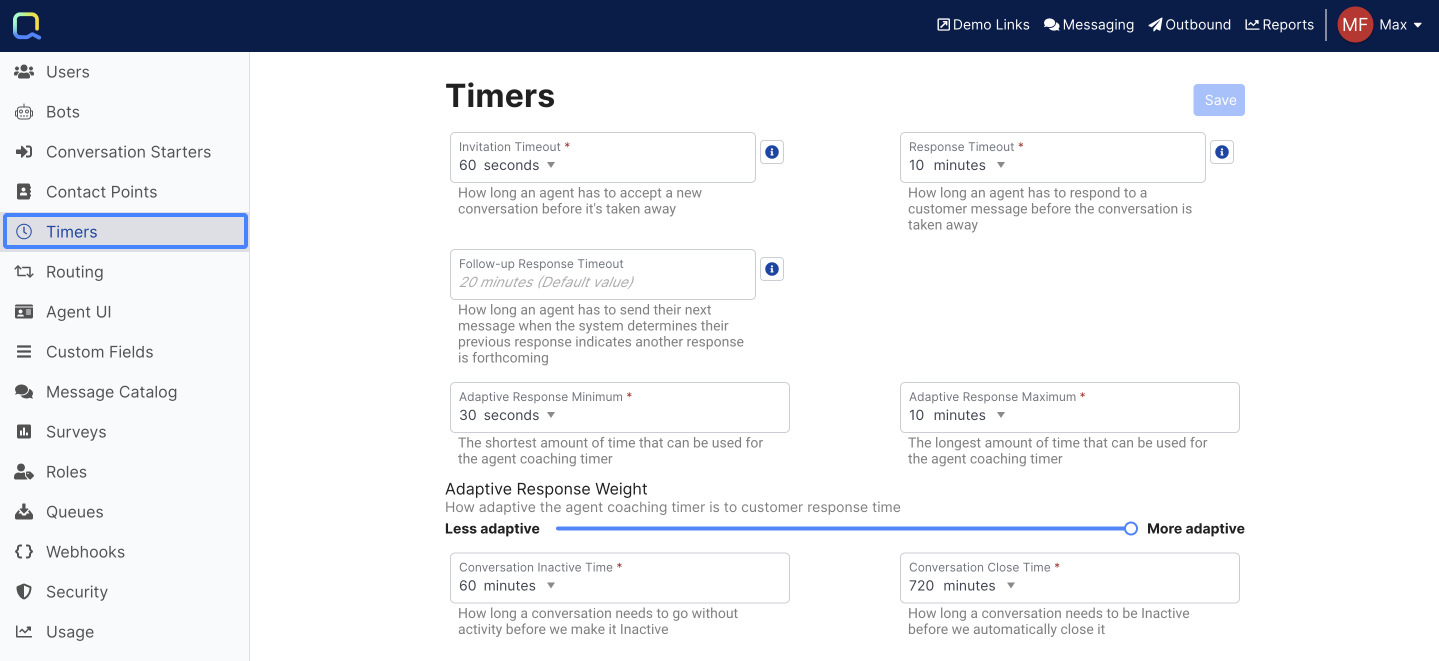Timers
Overview
Multiple events are governed by timers to aid in efficiently routing and handling conversations. These values are all Admin user editable and may be applied in seconds or minutes. It is important to understand the impact of these settings before changing from the default values.
Organizations may implement different standards for conversation acceptance and response times. These standards should support the agent workflow in addition to customer expectations.
Note also that Response Timeout, Conversation Inactive Time, and Conversation Close times, may be set both at the Contact Point level and the Platform level of each Contact Point. The most specific settings will apply.

Invitation Timeout
The duration that the conversation will be offered to an agent. A higher threshold increases the time a customer will wait for a response, but also allows multi-tasking agents to finish a task before accepting a conversation.
Agents who fail to acknowledge a conversation offer before the timer expires will be placed in Current Conversations Only status. Learn more
Response Timeout
When an agent is in an active conversation with a customer, and a customer sends a message, the agent must respond in this timeframe. If the agent does not respond before this timer expires, the conversation is re-queued, and the agent is placed in Current Conversations Only status.
The best customer experience is achieved when an agent can maintain the conversation, or gracefully hand off to another agent. This timer should reflect agent workflow and allow for multi-tasking as needed. This timer should also account for the adaptive response timer (below) and never have a value lower than the Adaptive Response Maximum.
Adaptive Response Minimum
Quiq’s Adaptive Response Timer (ART) measures the cadence and pace of a conversation, and coaches the agent to respond accordingly. SMS conversations may have longer periods between messages than chat, so the ART takes these into account, and provides a visual queue to the agent as to when the agent should respond. The minimum value is the shortest span the timer would display for a given conversation.
Adaptive Response Maximum
Similar to the above, this is the maximum time amount the ART will display. There is no consequence of the ART timer expiring, but this maximum should not be set higher than the Response Timeout value to ensure the agent is coached appropriately.
Adaptive Response Weight
This slider dampens or heightens the ART consideration of the customer response time. More adaptive is recommended, and allows the customer to drive the pace of the conversation. Less adaptive pushes the timer closer to the Adaptive Response Maximum.
Conversation Inactive Time
When no messages have been sent on a given conversation for the period defined here, the system will automatically mark the conversation inactive. Agents may only maintain a certain number of active and inactive conversations based upon the Routing settings . An agent may mark a conversation Inactive at any time.
If the agent limit is reached, or the agent is unavailable the conversation will be re-queued and offered to another available agent. Adjust this to allow most conversations to stay with a single agent, but still allow timely movement of conversations when needed. An attentive agent will typically mark a conversation inactive before this timer expires.
Conversation Close Time
This timer begins when a conversation is marked Inactive, either by an agent or by the system. This allows Inactive conversations to be removed from agent lists and finalized. Setting this too low will result in a single interaction spanning multiple conversations. A too high setting will cause Inactive conversations to accumulate with agents.
Note that the customer’s awareness of multiple conversations is driven by the auto responses received. The conversation history is displayed for the agent in any given conversation, so no information is lost as a result of closing a conversation. Maximum time allowed is 24 hours or 1440 minutes.
Conversations will close after 3 weeks, even if the customer is in queue.
Updated about 2 months ago
